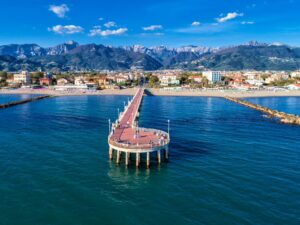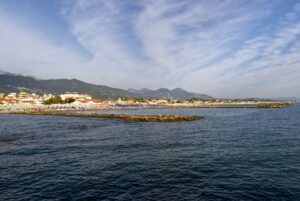The Massa CCLL served as a key pilot site for the implementation of SCORE’s Digital Twin and Early Warning Support (DT-EWS) System. The DT-EWS system was designed to help municipalities monitor real-time conditions, simulate extreme weather events, and assess potential flood impacts. The aim is to improve urban resilience by providing an integrated platform that combined predictive modelling with real-time data from sensors and weather forecasts.

What is the digital twin?
The DT-EWS has two main components, the User Scenario Evaluation (USE) and the Early Warning Support (EWS). The USE provides user-friendly visualisations of flood risk, models hypothetical climate scenarios, and tests the effectiveness of Nature-Based Solutions. By contrast, the Early Warning Support (EWS) subsystem can provide live alerts based on sensor readings and weather forecasts, helping emergency managers prepare for potential disasters. This integration of predictive and real-time analytics offered a more comprehensive approach to flood management compared to traditional tools, also providing a finer spatial resolution.
To start building Massa’s DT-EWS system, the Massa CCLL played a crucial role in supplying essential data to the development team. This included high-resolution maps, land use information, river geometry, and climate data, which were uploaded to the project’s data repository, SCORE ICT Platform. The DT system was calibrated to Massa’s local conditions, a process that required standardising the diverse data formats. Once operational, the DT-EWS continuously took-up real-time data inputs from weather stations and hydrological sensors (including those implemented through SCORE’s citizen science activities) in Massa, enabling the DT-EWS to generate flood risk projections and, when relevant, issue timely alerts to municipal authorities.
“I think about people coming out from the meetings and the materials like seeds in the community… they start speaking about say EBAs, the Digital Twin, with friends or colleagues… now there are these kinds of concepts that could spread… I think of Massa CCLL as a seeding event, not necessarily a solving event.” – Alberto Ortolani, LaMMA Consortium, Massa CCLL
What is the next step for the Digital Twin?
The DT-EWS was first developed for Massa CCLL, revealing several lessons learned. Standardising and integrating diverse datasets requires significant effort due to the many inconsistencies in data formats and units of measurement. Additionally, engaging local stakeholders early on was critical for ensuring the system met the needs of target users, particularly Massa’s urban planners and civil protection agencies. SCORE DT developers and the Massa CCLL facilitated two user engagement sessions to get feedback from these users to tailor the system to their needs more clearly. Massa’s experience demonstrated the value of a co-design approach, where feedback loops between developers and users helped refine the system’s usability and effectiveness.
Ultimately, Massa’s deployment of the DT-EWS set the stage for its adoption in other coastal cities. By combining advanced simulations with real-time monitoring, the system not only improved flood preparedness but also facilitated strategic urban planning. The pilot highlighted the importance of local adaptation and stakeholder involvement in making Digital Twin technology a practical tool for climate resilience.

